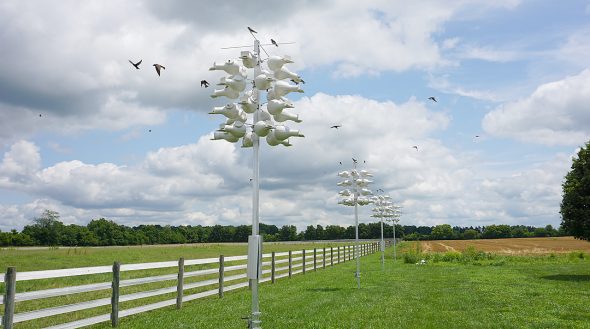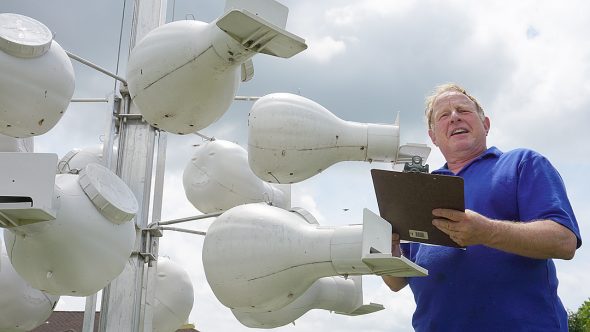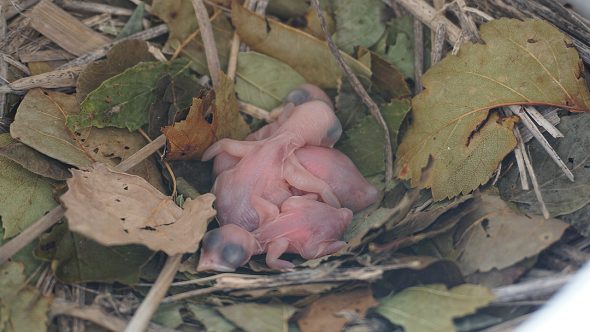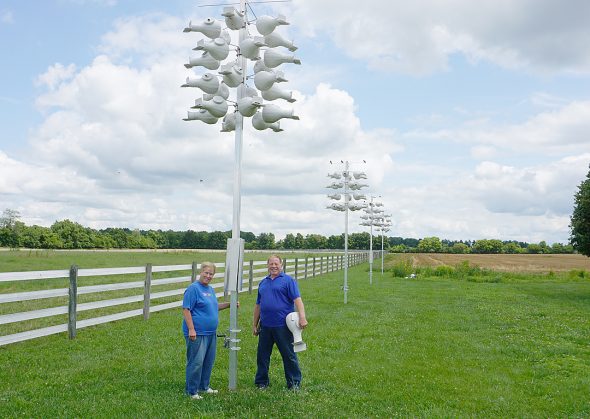
For 11 seasons, local residents Larry and Robin Weinstein have provided a spring and summer home to more than 600 purple martin birds on their 61-acre property along S.R. 343. The Weinsteins have built eight towers — each with 24 plastic gourds — to house the migratory birds. (Photo by Reilly Dixon)
Yellow Springs a home for purple martins, too
- Published: August 9, 2023
Next time you’re driving on S.R. 343 toward Clifton, you might notice a wide property with a bright, red barn. Running along a fence behind a house, there’s a series of tall, curious structures — not unlike whimsical tornado sirens. Notice also the small, black shapes that dart in and out of these structures, next time you’re out that way.
This is the 61-acre property of Larry and Robin Weinstein, and behind their own home, those structures are themselves a spring and summer home to more than 600 purple martin birds. Each of the eight tall poles holds a few dozen white, gourd-shaped containers, forming nearly 200 cavities where purple martins make their nests.
“I’ve got about 250 adults, and about 400 birds were fledged this year,” Larry Weinstein told the News in a recent interview.
The Weinsteins walked their land with two members of the News staff on a sunny day. Purple martins — a swallow variant, the males all-black with an overlaid blue luster and the females similar, with a lighter gray underbelly — perched on their towers. They poked their heads in and out of the gourds. On some tacit signal, groups of birds would occasionally take to the sky en masse. Birdsong filled the air.
Longtime area residents, the Weinsteins said they started hosting purple martins 11 years ago, several years before they retired — Larry Weinstein from a position as business professor at Wright State University, and Robin Weinstein as head librarian at the Fairborn branch of the Greene County Public Library. The couple’s interest was piqued, Robin Weinstein said, when a friend put up a birdhouse to attract purple martins in Springboro.
“I said, ‘Larry, let’s just try it,’ and we put up a simple, inexpensive house instead of the gourds we use now,” she said. “And that year, we had two. That’s what started our journey.”

Last month, Larry Weinstein, landlord to hundreds of purple martins, inspected 24 of his plastic gourds radially affixed to a tower. In many of the gourds are purple martin nests, and in some, featherless hatchlings. Larry and Robin Weinstein began their hobby of tending to the migratory birds 11 years ago, and every spring and summer since — that is, when the martins habitate in the region — they have spent many days cleaning nests, tracking maturation rates and occasionally feeding the birds. (Photo by Reilly Dixon)
More than a decade later, Robin Weinstein said the migratory birds — they winter in South America and return to the Weinsteins every year — are a beloved harbinger of spring.
“We have a running bet in March who hears or sees the first one,” she said, adding with a grin: “I think I won this year.”
As the birds almost always return in greater numbers than the previous year, the Weinsteins have incrementally increased the number of nesting gourds and towers they maintain each season. For the Weinsteins, maintenance includes removing potentially harmful mites, dead birds and eggs that never hatched, as well as placing young birds who have fledged too soon back into their nests.
“You have to be actively involved with it,” Larry Weinstein said. “That’s really the great enjoyment of being a landlord — you have a certain responsibility.”
“Landlord” is the preferred term used by folks around the country who contribute to the conservation of purple martins — a conservation necessary because of the birds’ unique relationship with humans.
Purple martins are secondary cavity nesters; unlike primary cavity nesters, such as woodpeckers, purple martins don’t dig out their own spaces in which to nest. Plenty of birds have similar behavior, nesting in already-excavated or naturally occurring holes in trees or rock faces. The behavior of purple martins in the eastern United States, however, presents a rare exception.
“At least east of the Mississippi River, [purple martins] are almost entirely dependent on humans,” Larry Weinstein said.
Ornithologists theorize that the genesis of this dependence dates back hundreds, if not thousands, of years, when people in Indigenous societies began hanging dried, hollow gourds in which the birds would roost. The availability and convenience of these human-crafted homes, combined with the gradual decrease in naturally occurring cavities in trees as the human population grew and spread, affected a complete tradition shift in the behavior of purple martins.
Because the lives of humans and purple martins are so intertwined, the Weinsteins said they feel emboldened to go the extra mile for their annual spring and summer tenants. Larry Weinstein showed the News a video from a previous nesting season in which he can be seen using a plastic spoon to flip crickets into the air; with each flick of the spoon, a purple martin would swoop down to grab a crunchy snack.
This year, the Weinsteins said, they had about 4,000 crickets delivered — minus the few that escaped into the corners of the Yellow Springs Post Office — in order to keep the birds fed.
“They’ll show up at the end of March or April, and often there aren’t enough bugs for them,” Larry Weinstein said. “You might have to [feed them] for a couple of weeks, but if you don’t, some will die of starvation.”
The Weinsteins also keep a freezer full of cleaned, dried chicken egg shells — donated over a period of six months by Current Cuisine — which female purple martins eat in order to replenish their calcium supply in anticipation of their own egg-laying.

Purple martin nests — especially those with babies — must be protected from predatory, nonnative house sparrows and starlings. Shown here are several martin babies nested in one of the Weinsteins’ plastic gourds. (Photo by Reilly Dixon)
Another part of being a good landlord is looking out for potential threats to purple martins, the couple said. Nonnative house sparrows and starlings are both known to squat in nesting gourds, and will kill young and adult purple martins who are already nesting or break incubating eggs.
“Occasionally I’ll open a gourd and [the nesting purple martins] will be decapitated — [house sparrows and starlings] are vicious birds, so you really need to track them and remove them,” Larry Weinstein said.
As they showed the News around the nesting gourd towers, the Weinsteins kept up an easy patter with one another; he asked her to bring him a ladder and a pen so he could climb up to one of the gourds and then write down — on a data sheet he faithfully keeps each season — the number of fledglings he spied. She reminded him of various bird-related anecdotes to share with the visiting reporters.
“Tell them about the dive-bombing,” she urged him.
“They do dive-bomb you sometimes,” he said.
“Well, they’re protecting their nests,” she added. “On my walks up to the barn, I know when I’m going to get dive-bombed; they make a certain sound. You look up and here it comes right at you. It’s so close that you feel it on your hair — but they never hurt me.”
Purple martins are joined by a host of other birds on the Weinsteins’ property. The couple said they often see mockingbirds, meadowlarks, red-winged blackbirds, killdeer and finches. Feeders near windows attract ruby-throated hummingbirds. Bluebird houses dot the perimeter of the fields they lease to local farmers. Barn swallows — which, along with chimney swifts, are the only other North American birds besides purple martins to nest exclusively in human structures — are also frequent nesters.
“That’s really only happened since we built here,” Robin Weinstein said. “One of my first goals was to start planting trees. And with the growth of the trees, the birds have come in.”
“That was my goal,” she added. “I love birds, and I love trees.”
Though their homestead is filled with the fluttering of wings — they also maintain small patches of wildflower prairie and don’t mow clover in order to attract pollinators — flying things aren’t the only interests the Weinsteins cultivate.
Living flying things, that is: Robin Weinstein is a self-professed “propellerhead,” with a love for classic aircraft. During the News interview, she stopped to point out a restored vintage airplane flying overhead.
“That’s the Champaign Gal — she’s the B-25 flying out of Grimes Field in Urbana,” she said.
In her spare time, Robin Weinstein is also a dressage scribe. A longtime lover of horses, and a horse rider herself, her work as a scribe means taking detailed notes to aid judges in dressage competition, an equine sport in which rider and horse work together to perform a series of prescribed movements. In 2010, she scribed at the World Equestrian Games in Lexington, Kentucky.
Larry Weinstein’s extra-avian activities include restoring classic cars in the same garage where he maintains a set of practice bells for his longtime vocation as a carillonneur — that is, a trained musician who plays the carillon bells. Since 1988, he has been the carillonneur for the Deeds Carillon, the 57-bell landmark of Dayton’s Carillon Park, where he presents concerts every year. He treated the News to a miniconcert on his practice set, starting with “Chopsticks” and ending with a brief and impressive baroque piece.

Robin and Larry Weinstein stood below one of their eight purple martin towers. (Photo by Reilly Dixon)
As diverse as their interests are, the Weinsteins said the bond they’ve formed with the purple martins that return every season has become the steady beat to which the rhythm of their lives has attuned.
“It gives me great satisfaction,” Robin Weinstein said.
They added that, although the conservation status of purple martins is listed as being of “least concern” by the International Union for Conservation of Nature, their population has been steadily declining in the eastern U.S. since the 1980s.
“If I remember right, the number of martins has dropped a third since then,” Larry Weinstein said.
The Weinsteins — and many other bird experts — attribute the decline to the lack of young people joining the purple martin landlord fold. According to a 2019 study published in “Conservation & Society,” the vast majority of landlords are 50 and older.
“What happens when we are gone and we sell the house?” Larry Weinstein said. “Suddenly you have hundreds of birds with nowhere to live if the next resident doesn’t want to have them.”
The couple acknowledged the amount of work they put into maintaining nesting gourds every year — but also noted that, with more than 200 gourds and more time on their hands since retirement, their way of doing things is not the only way. Though the Weinsteins and many other landlords have invested in specially made plastic gourds, there are other, more affordable routes: The hollow, dried natural gourds used hundreds of years ago still attract birds to this day.
“You can get as involved as you want,” Larry Weinstein said, and encouraged those interested to put up a gourd or two and see what happens.
“I almost think it’s better to have 10 people put up a few gourds than for one person to put up a hundred,” he said. “That way if one person stops, you still have other people doing it.”
He added: “And it can be hit or miss — some people get lots of birds the first year, and some try for years without success. But if you never put up a gourd, you’ll never know.”
For more information on purple martins, and how to get involved in their conservation, go to purplemartin.org.
One Response to “Yellow Springs a home for purple martins, too”
The Yellow Springs News encourages respectful discussion of this article.
You must login to post a comment.
Don't have a login? Register for a free YSNews.com account.















Thank you for reporting the dangers of non-native, invasive species (House Sparrows and European Starlings) to native cavity-nesting bird species. Their lethal aggression is one significant reason we have seen declines in native species like these and bluebirds in the past 100 years (in addition to habitat loss, increased pesticide use, etc.) Nesting bird boxes and cavities like this need monitored regularly during the nesting season. The Purple Martin Conservation Association and North American Bluebird Society are good resources for folks wanting to use best conservation practices.